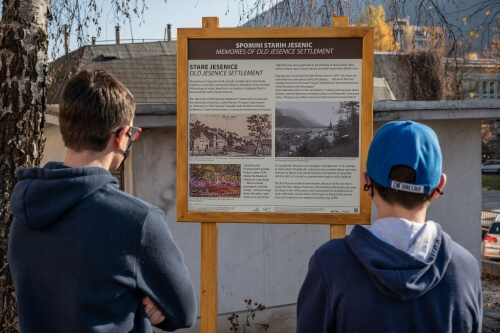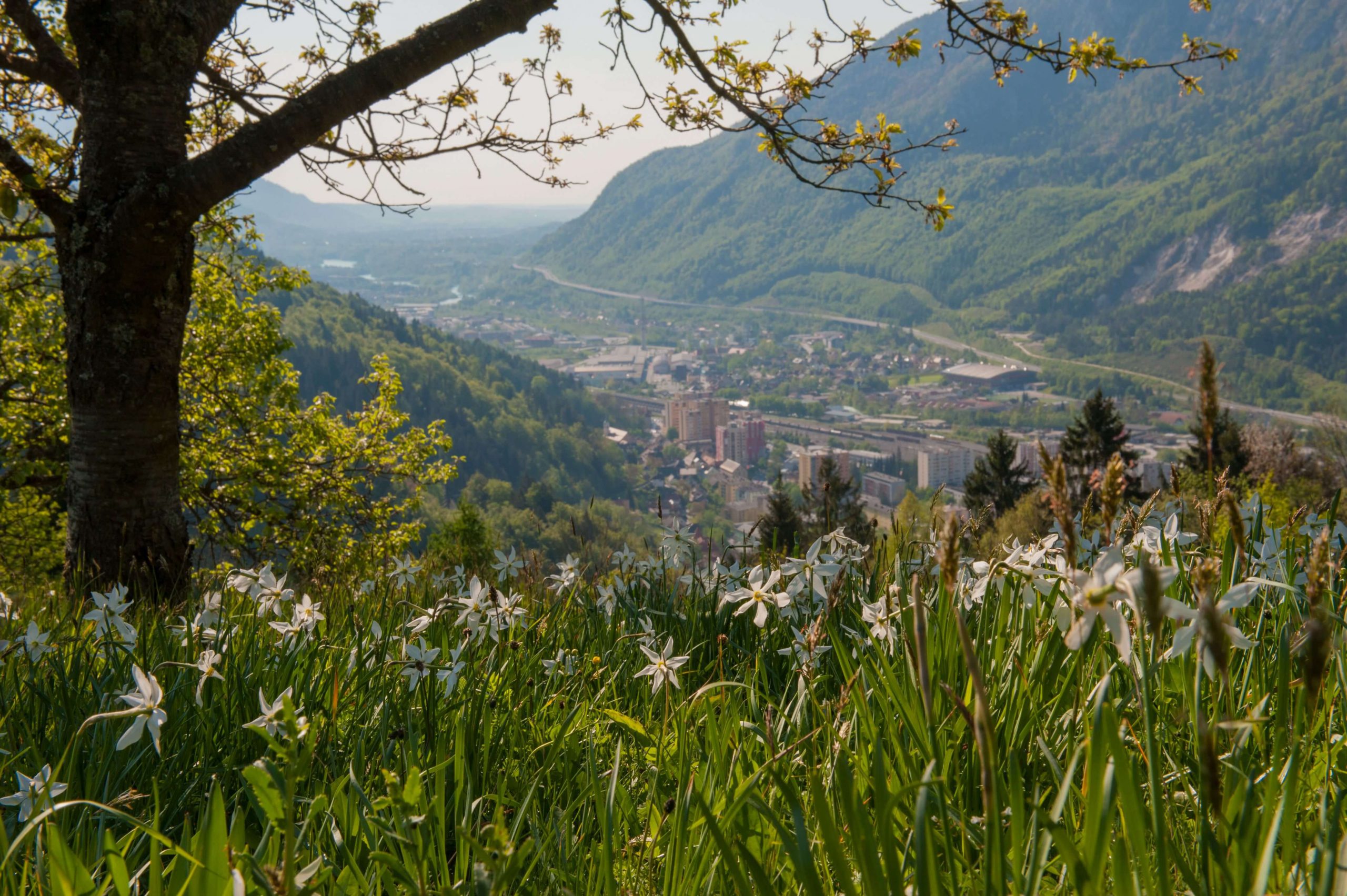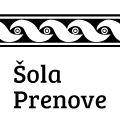In the footsteps of iron founders, iron and steel workers
The town under the Karavanke, which is famous for the best steel in the world, preserves the old heritage of iron founders and iron workers in a genuine way. Stroll in their footsteps to today’s town centre, visit a unique ironworks settlement, and the sports park of legendary hockey matches.
From the Čira čara villa to artists
Just opposite the railway station there is the Tourist Information Centre Jesenice (1), where you can arrange guided tours of the town. If you want to discover the town of steel workers on your own, take the Cesta maršala Tita Road to the nearby Valli Villa (2). You will immediately recognize the building from 1908 due to its notable architecture and decorative façade. The children of Jesenice also call it the Čira čara Villa, as it reminds them of Pipi Longstocking’s fairytale home. In the immediate vicinity of the villa is the Dolik Exhibition Salon (3) with exhibitions of works by domestic and foreign artists.
Recommended time for viewing: 5 minutes. The Dolik exhibition: 15 minutes.
From this to the next point: 1 minute.
To a lively square
If you go past the Jesenice Grammar School (4), one of the few preserved Art Nouveau buildings in the town, you will get to Tone Čufar Square, named after the Slovenian poet, writer and dramatist. Here, culture, entertainment, education and leisure activities meet. The square, which is cooled by a water fountain in summer and illuminated by festive lights in winter, is the venue of interesting events, such as the April Meteorite Science Fiction Festival. A library, cinema and theatre can also be found here (5).
A Tip: You can have a bite in the Chilli Restaurant, which is known for its Mexican specialities, or enjoy yourself in Cafe Teater with an excellent selection of drinks and ice creams.
Recommended time for viewing: 5 minutes.
From this to the next point: 3 minutes.
Across the bridges to Stara Sava
Before crossing Cesta železarjev Road, you can see an interesting TVD Partizan Jesenice building (6) on the left, built in 1929. Continue across the road and along the steel bridge through a beautifully landscaped newer part of the town. From here, exceptional views of the Upper Sava Valley can be enjoyed. And the most beautiful sunsets.
When you cross the next red bridge, you see a chimney, reminiscent of the old Jesenice “fabr’ka ” – an ironworks that gave daily bread to many townspeople. You have reached the Stara Sava museum area (7).
Experience iron foundries of times past
The settlement from the end of the 17th century surprises with the heritage of ironworks.
The Bucellini – Ruard Manor is the seat of the Slovenian Ironworks Museum (8). Next to the manor is the Church of the Assumption of the Virgin Mary (9), consecrated in 1606. In front of the church grows an ancient linden tree, where the locals have always liked to meet.
A stroll past the water channels called the rake brings you to Kasarna (10), a workers’ multi-apartment house from the 18th century. It offers a permanent ethnological exhibition with a reconstructed workers’ apartment. After visiting nearby Kolpern (11), a former charcoal storage, which is now converted into a banquet hall, head back across the square. Cross the rake and stop at the open-air museum (12) where the exhibits of technical heritage and the Images of Work photo gallery await you.
Recommended time for viewing: 1.5 hours.
From this to the next point: 7 minutes.
Learn about hockey across the river
After soaking in ironworks stories, head along the water channels to the Herman Bridge (13) over the Sava Dolinka River. Cross the bridge and take Ulica heroja Verdnika Street to the Podmežakla sports park, the central venue of the legendary Jesenice hockey (14). On the way from the park, cross the Sava Dolinka once more and then take the railway underpass to the Ejga guest house (15), where two famous athletes combine sports and culinary stories in an original manner.
A Tip: Next to the Podmežakla hall, there is a sports park with possibilities for various activities. This is also the starting point for a lengthy cycling tour to Kranjska Gora. Above the park rises the Mežakla plateau with the Špica lookout point. From here a beautiful view of the town that you managed on foot can be enjoyed!
Recommended time for viewing: 10 minutes.
From this to the next point: 4 minutes.
The end or continuation?
From the guest house you can return to the starting point and complete your tour at the Jesenice railway station (16). Its modernist architecture is worth a visit!
If you are tempted to get to know the foundry heritage further, follow the Cesta maršala Tita Road to Kos Manor (17). The interesting ironworks manor is an exhibition space for museum and art exhibitions. Opposite the Manor is the Jesenice Memorial Park (18). Just above Kos Manor, the theme trail called Memories of old Jesenice settlement starts (19).
Suggestions for a hike
Across Ukova to views of the town
From Tone Čufar Square, follow the Tone Tomšič Road and the short path between the primary school and the kindergarten towards the steps leading to the Ukova swimming pool, where the bravest enjoy the 10-meter dives. A scenic path over the town begins to the left of the swimming pool. An easy 20-minute walk takes you to the Church of St. Leonard in Murova – the oldest part of Jesenice. The church, mentioned as early as 1460, is considered one of the most beautiful sacral buildings in the area. While it was built in Gothic style, it got Baroque decoration in the 18th century.
More information: TIC Jesenice

1. Jesenice Tourist Information Centre
In the TIC, opposite the train station you get all the information and inspiration for the experiences of Jesenice. Here you can stock up on guides, maps, brochures and souvenirs.
Cesta maršala Tita, T: 04 586 31 78
2. The Valli villa

The villa, built in 1908, was designed by architect Alberto Valli, a native of Switzerland. The villa with Art Nouveau interior is privately owned. From the outside you can admire the decorative façade in a combination of cement asbestos, stone blocks, bricks, plaster and wooden elements.
Cesta Maršala Tita 13
3. The Dolik exibition salon

Since the end of the Second World War, the cultural pulse of Jesenice has been enriched by local artists united in the Dolik Art Club. They have been organizing various exhibitions in the Koželj House, which is the venue of prominent domestic and foreign artists, since 1983. Group exhibitions of amateur painters are also frequent. Free entrance.
Cesta maršala Tita 12, 041 31 77 35
4. Jesenice Grammar school

The building was built according to Rudolf Petz’s plans in 1914. After the First World War, it housed a public school, and since 1958 it has been used for secondary education. Take a look at the rhombus stucco details on the front façade. They are complemented by shallow reliefs depicting boys, symbolizing science.
Trg Toneta Čufarja 1
5. Tone Čufar Theatre

The building, built in 1930 as Krek Cultural Centre, has been dedicated to cultural activities since its beginning. It has housed the main municipal theatre since 1945. Radio Triglav and the Železar cinema are also found here. Amateur theatre activity in Jesenice has a more than 100-year tradition. For several decades, Čufar’s Days – a big festival of amateur theatres – have been organized here every year.
Trg Toneta Čufarja 4
6. TVD Partizan Jesenice
The SOKOL sports society was founded in 1904, so sport has a rich tradition in Jesenice. Over the years, the society has hatched countless acrobats, who achieve top results in various sports disciplines. Today, it is called Partizan Jesenice, an association for sports recreation and physical education.
7. Stara Sava

Stara Sava is one of the most interesting and best preserved iron foundry settlements in Europe. At the confluence of the Sava Dolinka River and the Ukova Torrent, the essential elements of the 17th century settlement are preserved in a relatively small area: a mansion, a church, a workers’ house, a blast furnace with auxiliary plants, the rake water channel and a mill. Due to its exceptional urban, technical, architectural and historical significance, the square is a national cultural monument. You can see several museum collections here.
Cesta Franceta Prešerna 45, Jesenice: The Upper Sava Valley Museum, T: 04 583 35 00
8. The Slovenian ironworks museum at Bucelleni-Ruard manor
Bucelleni-Ruard Manor was built around 1538. The Baroque accents were added after renovations in 1766 and the mid-19th century. In the Manor in the middle of the Stara Sava museum area, the Slovenian Ironworks Museum presents the path of iron from ore to steel. Models of blast furnaces, iron foundries, charcoal making process and the Pantz cable car are on display, as well as a reconstructed smithy with a blacksmith’s hammer and other original tools.
Cesta Franceta Prešerna 45, Jesenice: The Upper Sava Museum, T: 04 583 35 00
9. The church of the Asumption of the virgin Mary
The church was built by the Bucelleni family and consecrated by the Bishop of Ljubljana, Tomaž Hren. The main altar is made of black marble. Until its closure in the 1950s, the church was adorned with works of art by the Venetian painter Nicola Grassi (1682 – 1748), who painted three altarpieces: the Assumption of Mary, St. Maryof the Rosary with St. Dominic and Francis of Assisi, and St. Anthony the Hermit with an ancient martyr.
Stara Sava
10. Ethnological collection at Kasarna
Kasarna, a late Baroque building from the end of the 18th century, is one of the oldest preserved examples of common workers’ flats in Slovenia. The ethnological exhibition presents the living culture and a way of life of ironmaking families in the past. Here, a reconstructed workers’ apartment from the 1930s and 1940s is on display. On the upper floor you can hear the melodies of the students of the Jesenice Music School, which has a rich 74-year tradition.
Cesta Franceta Prešerna 45, Jesenice: The Upper Sava Valley Musem, T: 04 583 35 00
11. Kolpern
The Sava covered air storage for charcoal stood right next to the blast furnace, to which charcoal was added as fuel. With the abandonment of the blast furnace at the end of the 19th century, the purpose of Kolpern changed. Today, it is intended for protocol and cultural events.
Cesta Franceta Prešerna 45, Jesenice: The Upper Sava Valley Musem, T: 04 583 35 00
12. Open-air museum
The permanent exhibition of technical heritage in Stara Sava includes images of work, exhibition panels and restored technical monuments of the former Jesenice Ironworks and its predecessor, the Carniolan Industrial Society. See exhibits related to the production and processing of steel, electrical supply and transportation. The wall of the covered event space is adorned with a painting of more than 300 square meters, created by the Polish street artist M-city.
Cesta Franceta Prešerna 45, The Upper Sava Valley Museum T: 04 583 35 00
13. Herman’s bridge

Fužinar Leopold Ruard je blizu svoje graščine dal že leta 1824 postaviti verižni most čez reko Savo Dolinko. Most je bil močno poškodovan v poplavah leta 1851, ki so močno prizadele celotno savsko fužino. Nov most, dolg 32 metrov in širok 3 metre, je bil zgrajen leta 1904. Po njem so v fužino prihajali delavci z desnega brega Save. Most je povezoval občini Gorje in Jesenice. Po letu 1926, ko je povodenj odnesla most na Javorniku, se je promet čez most pri Hermanu zelo povečal in nastala je potreba po večjem mostu. Obnovitvena dela so potekala v letih 1930 in 1931. Leta 1962 je most dobil današnjo obliko.
Cesta Franceta Prešerna 38, Jesenice
14. Hockey

On the shady side of Jesenice, where the ice was preserved long into the spring, hockey matches were popular even before the Second World War. In 1954, the first ice rink in the former Yugoslavia was built here. Legendary Jesenice hockey players won 23 national championships until 1991, when Slovenia gained its independence. The Hall gained its present shape in 2013 when Jesenice hosted a part of the European Basketball championship. Next to the multi-purpose hall there is a sports park with many outdoor facilities: basketball and tennis courts, a soccer field, athletics course, a mini soccer filed and outdoor fitness equipment.
the Podmežakla Sports Hall, Jesenice Sports Institution, Ledarska ulica 4 04 5884 662
15. Ejga Guest house

Athletes Alenka Dovžan, a world-famous skier, and Edvin Karahodžič, a former hockey player, greet their guests at the site where there used to be an inn with accommodation a century ago. A collection of memorabilia from their sports days is on display in the inn with a touch of ironworks tradition. The guesthouse is famous for its excellent cuisine and tasty specialities.
Cesta maršala Tita 27, T: 041 686 858
16. Jesenice railway station
This large and grandiose station, opened in 1956, is the work of architect Stanislav Rohrman. The exterior and the entrance hall were entirely lined with stone slabs, while the staircases and the underpass were lined with ceramic tiles. The station complex around the central building was later remodelled. An important acquisition was the railway underpass, built in 1966, which connected the town centre with Podmežakla together with the bridge over the Sava.
Cesta maršala Tita 17
17. Kos manor
The manor, built in 1521, is also known as the old Bela Peč castle. Above the balcony door one can still see the coat of arms of the Bela Peč nobility. In the 19th century, the merchant Kos, after whom the manor is named, restored the building in a classicist style. In the 20th century it housed a public school, offices, a court and a prison. The manor also houses one of the largest collections of fossils and rocks in Slovenia. For a visit make an appointment at the Upper Sava Valley Museum.
Cesta maršala Tita 64, Gornjesavski muzej Jesenice, T: 04 583 20 61
18. Jesenice Memorial park
In the park with more than 200 species of ornamental trees and shrubs, a wall with tombstones from an abandoned cemetery is still preserved. Here are the military chapel with the ossuary of the fallen soldiers in the First World War and the cemetery of 42 fighters who fell in the Second World War. There are several statues in the park, dedicated to the important local people and the builders of the Karavanke railway tunnel. The park, now a popular green retreat of the town, was voluntarily arranged after 1961 by horticulture lovers.
Cesta Cirila Tavčarja 1
19. Memories of old Jesenice settlement theme trail
The trail with seven interesting information boards, which also bear testimonies of the local townspeople, represents the oldest part of the town, called Murova. Stroll to the mayor’s castle, to the gorges, which were once the most important source of water supply, and to the simple kajžar houses with wooden floors. On this walk you will discover many interesting stories and also stop in front of the birthplace of Tone Čufar.
Murova 1, Jesenice
- 11. Jesenice Tourist Information Centre
- 22. The Valli villa
- 33. The Dolik exibition salon
- 44. Jesenice Grammar school
- 55. Tone Čufar Theatre
- 66. TVD Partizan Jesenice
- 77. Stara Sava
- 88. The Slovenian ironworks museum at Bucelleni-Ruard manor
- 99. The church of the Asumption of the virgin Mary
- 1010. Ethnological collection at Kasarna
- 1111. Kolpern
- 1212. Open-air museum
- 1313. Herman’s bridge
- 1414. Hockey
- 1515. Ejga Guest house
- 1616. Jesenice railway station
- 1717. Kos manor
- 1818. Jesenice Memorial park
- 1919. Memories of old Jesenice settlement theme trail





